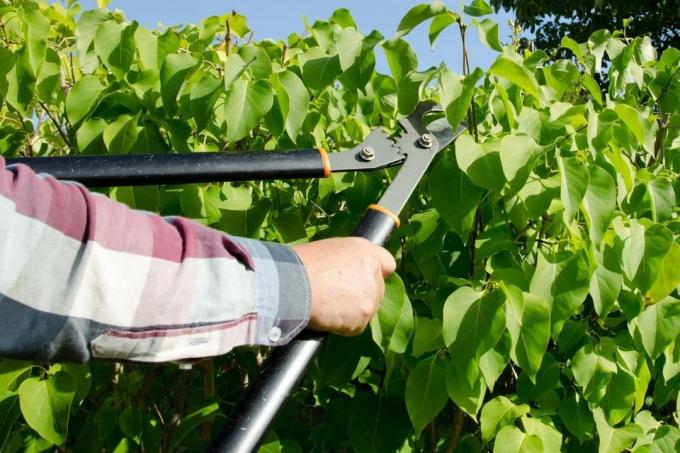
table of contents
- Why cut back lilacs?
- tool
- time
- Cutting lilacs on a stick: instructions
- Aftercare
- frequently asked Questions
In old age tends lilac to bald and blooms less and less. It regains its old beauty through a strong cut back. How to cut the lilac on the stick is in this article.
In a nutshell
- Lilac usually has a large number of fragrant flowers
- Pruning maintains flowering potential
- if the shrub is too old, pruning helps
- Stick drives out again
- alternatively, many runners form
Why cut back lilacs?
Lilac is relatively easy to care for. A pruning is not always necessary, especially not a radical one. Usually it is enough to remove what has faded. A thicker cut makes sense under these circumstances:
- lack of flowering potential
- balding from the inside
- unkempt appearance (including root runners)
- too dense crown
- Flowers and shoots too weak and small
- got too big
tool
The same tools that are used for other pruning measures in the garden are suitable for cutting the lilac:
- Secateurs
- Pruning saw
- gloves
- possibly ladder or folding step

Note: Cutting tools always have to very sharp and be clean. It is even better to disinfect them after every bush or tree.
time
While a slight pruning takes place after flowering, the radical pruning of the lilac is carried out in early spring. When it drives out, it immediately begins to form new shoots.
Note: Do not be afraid of frost damage, the lilac can withstand a lot of cold.
Cutting lilacs on a stick: instructions
- It is possible to simply cut the lilac, if it has only one trunk, about 30 cm above the ground. In the case of very large shrubs, this is only advisable if you work in pairs.
- It is better to cut back the lilacs little by little. For this purpose, thicker branches in particular are cut with the saw from the outside to the inside. The cut should be made at a slight angle. Rainwater then flows off better.
- In the case of single-stemmed lilacs, the trunk is shortened to a height of 30 to 50 cm. All root runners are also removed, simply tear them out while they are still small.
- If the lilac has grown with multiple stems, the weaker shoots are removed near the ground. The stronger ones are shortened to different heights. The shortest at about 10 cm, the longest at knee level. At the end, depending on the size of the shrub, about 5 to 7 shoots should remain.

Alternative possibility
If you don't want to treat the lilac so radically, you can extend the pruning measures over several years. Then the shrub is only partially cut back each spring. With this variant, the uncut parts of the plant still bloom, so that the bloom does not fail completely for several years.
Aftercare
Cutting back is not enough. If no aftercare is carried out afterwards, healthy lilacs will sprout vigorously, including many Runners and forms a chaos of long shoots that branch out and a very dense one Form crown. The following tips are helpful so that the crown makes a light, well-groomed impression:
- shoots lilacs on the old stick, remove all root runners
- if it does not sprout on the old trunk, select a few strong runners, remove the rest
- Shorten shoots a little, then branch better
- build up a loose crown
- Always remove weaker shoots at the point of attachment or near the ground
- Lilac with compost fertilize, mulch the root area and water when it is dry

frequently asked Questions
Noble lilacs in particular, which like to form numerous runners and grow very large, benefit from a strong pruning. You can also cut dwarf lilac on the stick.
If the wound has clean edges and has been cut at a slight bevel, no further treatment is necessary. It heals on its own. If the lilac is to sprout again from a runners, the old remains can be removed at some point.
That can take quite a while. The first flowers can return after about two years. A really big bloom does not appear again until the new crown is built up.

